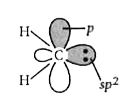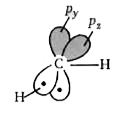Explain the
A singlet carbene has a bent structure.
Step-by-Step Solution:
1. Understanding Carbene:
- A carbene is a reactive intermediate containing a carbon atom with two unshared electrons. The simplest example is methylene (CH₂).
2. Types of Carbenes:
- Carbenes can exist in two states: singlet and triplet. In a singlet carbene, the two unpaired electrons are in the same orbital with opposite spins.
3. Electron Configuration:
- In singlet carbenes, the two unpaired electrons occupy the same p-orbital. This configuration leads to increased electron-electron repulsion because both electrons are in close proximity.
4. Molecular Geometry:
- The presence of this repulsion affects the geometry of the molecule. Instead of adopting a linear structure, the molecule bends due to the repulsion between the two electrons.
5. Bond Angle:
- The bond angle in a singlet carbene is typically around 100 to 110 degrees. This angle is less than the ideal tetrahedral angle (109.5 degrees) but more than the angle in a linear structure (180 degrees).
6. Conclusion:
- Thus, the bent structure of singlet carbenes arises due to the repulsion between the two electrons in the same orbital, resulting in a bond angle that reflects this repulsion.
- A carbene is a reactive intermediate containing a carbon atom with two unshared electrons. The simplest example is methylene (CH₂).
- Carbenes can exist in two states: singlet and triplet. In a singlet carbene, the two unpaired electrons are in the same orbital with opposite spins.
- In singlet carbenes, the two unpaired electrons occupy the same p-orbital. This configuration leads to increased electron-electron repulsion because both electrons are in close proximity.
- The presence of this repulsion affects the geometry of the molecule. Instead of adopting a linear structure, the molecule bends due to the repulsion between the two electrons.
- The bond angle in a singlet carbene is typically around 100 to 110 degrees. This angle is less than the ideal tetrahedral angle (109.5 degrees) but more than the angle in a linear structure (180 degrees).
- Thus, the bent structure of singlet carbenes arises due to the repulsion between the two electrons in the same orbital, resulting in a bond angle that reflects this repulsion.
Topper's Solved these Questions
- ORGANIC CHEMISTRY : SOME BASIC PRINCIPLES AND TECHNIQUES BOOK - ICSECHAPTER - ORGANIC CHEMISTRY : SOME BASIC PRINCIPLES AND TECHNIQUES EXERCISE - VERY SHORT ANSWER TYPE QUESTIONS
87 Videos
- ORGANIC CHEMISTRY : SOME BASIC PRINCIPLES AND TECHNIQUES BOOK - ICSECHAPTER - ORGANIC CHEMISTRY : SOME BASIC PRINCIPLES AND TECHNIQUES EXERCISE - SHORT ANSWER TYPE QUESTIONS
110 Videos
- ORGANIC CHEMISTRY : SOME BASIC PRINCIPLES AND TECHNIQUES BOOK - ICSECHAPTER - ORGANIC CHEMISTRY : SOME BASIC PRINCIPLES AND TECHNIQUES EXERCISE - NCERT TEXT-BOOK EXERCISES (WITH HINTS AND SOLUTIONS )
72 Videos
- HYDROGENBOOK - ICSECHAPTER - HYDROGENEXERCISE - NCERT TEXT-BOOK EXERCISE (With Hints and Solutions)
53 Videos
- REDOX REACTIONS (OXIDATION AND REDUCTION)BOOK - ICSECHAPTER - REDOX REACTIONS (OXIDATION AND REDUCTION)EXERCISE - NCERT TEXT-BOOK. EXERCISES ((With Hints and Solutions)
69 Videos
Similar Questions
Knowledge Check
The orbital picture of a singlet carbene (:CH2) can be drawn as:
A B
B C
C Dnone of these
Dnone of these
Explain the terms primary and secondary structures of proteins. What is the difference between α-helix and β-pleated sheet structure of proteins?
View SolutionWhat are carbenes ?
View SolutionExplain the following situations :
(i) In the structure of HNO3 molecule , the N-O bond (121 pm) is shorter than N-OH bond (140pm).
(ii) SF4 is easily hydrolysed whereas SF6 is not easily hydrolysed.
(iii) XeF2 has a straight linear structure and not a bent angular structure.
View SolutionExplain the fine structure of a striated muscle.
View SolutionWhich compound has planar structure:
View SolutionWhich compound has planar structure:
View SolutionThe melecule that has linear structure is:
View Solution
